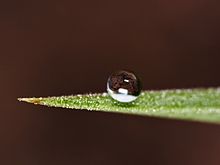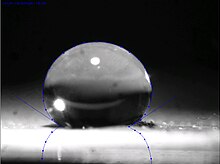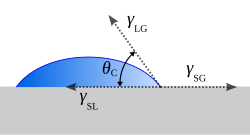Hydrophobe



In chemistry, hydrophobicity is the chemical property of a molecule that is seemingly repelled from a mass of water (called a hydrophobe).[1] In contrast, hydrophiles are attracted to water.
Hydrophobic molecules tend to be nonpolar and, thus, prefer other neutral molecules and nonpolar solvents. Because water molecules are polar, hydrophobes do not dissolve well among them. Hydrophobic molecules in water often cluster together, forming micelles. Water on hydrophobic surfaces will exhibit a high contact angle.
Examples of hydrophobic molecules include the alkanes, oils, fats, and greasy substances in general. Hydrophobic materials are used for oil removal from water, the management of oil spills, and chemical separation processes to remove non-polar substances from polar compounds.[2]
Hydrophobic is often used interchangeably with lipophilic, "fat-loving". However, the two terms are not synonymous. While hydrophobic substances are usually lipophilic, there are exceptions, such as the silicones and fluorocarbons.[citation needed]
The term hydrophobe comes from the Ancient Greek ὑδρόφοβος (hydróphobos), "having a fear of water", constructed from Ancient Greek ὕδωρ (húdōr) 'water' and Ancient Greek φόβος (phóbos) 'fear'.[3]
Chemical background
[edit]The hydrophobic interaction is mostly an entropic effect originating from the disruption of the highly dynamic hydrogen bonds between molecules of liquid water by the nonpolar solute, causing the water to form a clathrate-like structure around the non-polar molecules. This structure formed is more highly ordered than free water molecules due to the water molecules arranging themselves to interact as much as possible with themselves, and thus results in a higher entropic state which causes non-polar molecules to clump together to reduce the surface area exposed to water and decrease the entropy of the system.[4][5] Thus, the two immiscible phases (hydrophilic vs. hydrophobic) will change so that their corresponding interfacial area will be minimal. This effect can be visualized in the phenomenon called phase separation.[citation needed]
Superhydrophobicity
[edit]
Superhydrophobic surfaces, such as the leaves of the lotus plant, are those that are extremely difficult to wet. The contact angles of a water droplet exceeds 150°.[6] This is referred to as the lotus effect, and is primarily a chemical property related to interfacial tension, rather than a chemical property.[7]
Theory
[edit]In 1805, Thomas Young defined the contact angle θ by analyzing the forces acting on a fluid droplet resting on a solid surface surrounded by a gas.[8]


where
- = Interfacial tension between the solid and gas
- = Interfacial tension between the solid and liquid
- = Interfacial tension between the liquid and gas
θ can be measured using a contact angle goniometer.
Wenzel determined that when the liquid is in intimate contact with a microstructured surface, θ will change to θW*
where r is the ratio of the actual area to the projected area.[9] Wenzel's equation shows that microstructuring a surface amplifies the natural tendency of the surface. A hydrophobic surface (one that has an original contact angle greater than 90°) becomes more hydrophobic when microstructured – its new contact angle becomes greater than the original. However, a hydrophilic surface (one that has an original contact angle less than 90°) becomes more hydrophilic when microstructured – its new contact angle becomes less than the original.[10] Cassie and Baxter found that if the liquid is suspended on the tops of microstructures, θ will change to θCB*:
where φ is the area fraction of the solid that touches the liquid.[11] Liquid in the Cassie–Baxter state is more mobile than in the Wenzel state.[citation needed]
We can predict whether the Wenzel or Cassie–Baxter state should exist by calculating the new contact angle with both equations. By a minimization of free energy argument, the relation that predicted the smaller new contact angle is the state most likely to exist. Stated in mathematical terms, for the Cassie–Baxter state to exist, the following inequality must be true.[12]
A recent alternative criterion for the Cassie–Baxter state asserts that the Cassie–Baxter state exists when the following 2 criteria are met:1) Contact line forces overcome body forces of unsupported droplet weight and 2) The microstructures are tall enough to prevent the liquid that bridges microstructures from touching the base of the microstructures.[13]
A new criterion for the switch between Wenzel and Cassie-Baxter states has been developed recently based on surface roughness and surface energy.[14] The criterion focuses on the air-trapping capability under liquid droplets on rough surfaces, which could tell whether Wenzel's model or Cassie-Baxter's model should be used for certain combination of surface roughness and energy.[citation needed]
Contact angle is a measure of static hydrophobicity, and contact angle hysteresis and slide angle are dynamic measures. Contact angle hysteresis is a phenomenon that characterizes surface heterogeneity.[15] When a pipette injects a liquid onto a solid, the liquid will form some contact angle. As the pipette injects more liquid, the droplet will increase in volume, the contact angle will increase, but its three-phase boundary will remain stationary until it suddenly advances outward. The contact angle the droplet had immediately before advancing outward is termed the advancing contact angle. The receding contact angle is now measured by pumping the liquid back out of the droplet. The droplet will decrease in volume, the contact angle will decrease, but its three-phase boundary will remain stationary until it suddenly recedes inward. The contact angle the droplet had immediately before receding inward is termed the receding contact angle. The difference between advancing and receding contact angles is termed contact angle hysteresis and can be used to characterize surface heterogeneity, roughness, and mobility.[16] Surfaces that are not homogeneous will have domains that impede motion of the contact line. The slide angle is another dynamic measure of hydrophobicity and is measured by depositing a droplet on a surface and tilting the surface until the droplet begins to slide. In general, liquids in the Cassie–Baxter state exhibit lower slide angles and contact angle hysteresis than those in the Wenzel state.[citation needed]
Research and development
[edit]Dettre and Johnson discovered in 1964 that the superhydrophobic lotus effect phenomenon was related to rough hydrophobic surfaces, and they developed a theoretical model based on experiments with glass beads coated with paraffin or TFE telomer. The self-cleaning property of superhydrophobic micro-nanostructured surfaces was reported in 1977.[17] Perfluoroalkyl, perfluoropolyether, and RF plasma -formed superhydrophobic materials were developed, used for electrowetting and commercialized for bio-medical applications between 1986 and 1995.[18][19][20][21] Other technology and applications have emerged since the mid-1990s.[22] A durable superhydrophobic hierarchical composition, applied in one or two steps, was disclosed in 2002 comprising nano-sized particles ≤ 100 nanometers overlaying a surface having micrometer-sized features or particles ≤ 100 micrometers. The larger particles were observed to protect the smaller particles from mechanical abrasion.[23]
In recent research, superhydrophobicity has been reported by allowing alkylketene dimer (AKD) to solidify into a nanostructured fractal surface.[24] Many papers have since presented fabrication methods for producing superhydrophobic surfaces including particle deposition,[25] sol-gel techniques,[26] plasma treatments,[27] vapor deposition,[25] and casting techniques.[28] Current opportunity for research impact lies mainly in fundamental research and practical manufacturing.[29] Debates have recently emerged concerning the applicability of the Wenzel and Cassie–Baxter models. In an experiment designed to challenge the surface energy perspective of the Wenzel and Cassie–Baxter model and promote a contact line perspective, water drops were placed on a smooth hydrophobic spot in a rough hydrophobic field, a rough hydrophobic spot in a smooth hydrophobic field, and a hydrophilic spot in a hydrophobic field.[30] Experiments showed that the surface chemistry and geometry at the contact line affected the contact angle and contact angle hysteresis, but the surface area inside the contact line had no effect. An argument that increased jaggedness in the contact line enhances droplet mobility has also been proposed.[31]
Many hydrophobic materials found in nature rely on Cassie's law and are biphasic on the submicrometer level with one component air. The lotus effect is based on this principle. Inspired by it, many functional superhydrophobic surfaces have been prepared.[32]
An example of a bionic or biomimetic superhydrophobic material in nanotechnology is nanopin film.[citation needed]
One study presents a vanadium pentoxide surface that switches reversibly between superhydrophobicity and superhydrophilicity under the influence of UV radiation.[33] According to the study, any surface can be modified to this effect by application of a suspension of rose-like V2O5 particles, for instance with an inkjet printer. Once again hydrophobicity is induced by interlaminar air pockets (separated by 2.1 nm distances). The UV effect is also explained. UV light creates electron-hole pairs, with the holes reacting with lattice oxygen, creating surface oxygen vacancies, while the electrons reduce V5+ to V3+. The oxygen vacancies are met by water, and it is this water absorbency by the vanadium surface that makes it hydrophilic. By extended storage in the dark, water is replaced by oxygen and hydrophilicity is once again lost.[citation needed]
A significant majority of hydrophobic surfaces have their hydrophobic properties imparted by structural or chemical modification of a surface of a bulk material, through either coatings or surface treatments. That is to say, the presence of molecular species (usually organic) or structural features results in high contact angles of water. In recent years, rare earth oxides have been shown to possess intrinsic hydrophobicity.[34] The intrinsic hydrophobicity of rare earth oxides depends on surface orientation and oxygen vacancy levels, and is naturally more robust than coatings or surface treatments, having potential applications in condensers and catalysts that can operate at high temperatures or corrosive environments.[35]
Applications and potential applications
[edit]Hydrophobic concrete has been produced since the mid-20th century.[citation needed]
Active recent research on superhydrophobic materials might eventually lead to more industrial applications.[36]
A simple routine of coating cotton fabric with silica[37] or titania[38] particles by sol-gel technique has been reported, which protects the fabric from UV light and makes it superhydrophobic.
An efficient routine has been reported for making polyethylene superhydrophobic and thus self-cleaning.[39] 99% of dirt on such a surface is easily washed away.
Patterned superhydrophobic surfaces also have promise for lab-on-a-chip microfluidic devices and can drastically improve surface-based bioanalysis.[40]
In pharmaceuticals, hydrophobicity of pharmaceutical blends affects important quality attributes of final products, such as drug dissolution and hardness.[41] Methods have been developed to measure the hydrophobicity of pharmaceutical materials.[42][43]
The development of hydrophobic passive daytime radiative cooling (PDRC) surfaces, whose effectiveness at solar reflectance and thermal emittance is predicated on their cleanliness, has improved the "self-cleaning" of these surfaces. Scalable and sustainable hydrophobic PDRCs that avoid VOCs have further been developed.[44]
See also
[edit]- Froth flotation – Process for selectively separating of hydrophobic materials from hydrophilic
- Hydrophile – Molecular entity that is attracted to water
- Hydrophobic effect – Aggregation of non-polar molecules in aqueous solutions
- Hydrophobicity scales – relative hydrophobicity or hydrophilicity of amino acid residues
- Silicon organic water repellent
- Superhydrophobic coating – Water-repellant coating
- Ultrahydrophobicity, also known as superhydrophobicity – Material property of extreme resistance to wetting
References
[edit]- ^ Ben-Na'im, Aryeh. Hydrophobic Interaction. New York: Plenum Press. ISBN 0-306-40222-X.
- ^ Akhavan B, Jarvis K, Majewski P (November 2013). "Hydrophobic Plasma Polymer Coated Silica Particles for Petroleum Hydrocarbon Removal". ACS Appl. Mater. Interfaces. 5 (17): 8563–8571. doi:10.1021/am4020154. PMID 23942510.
- ^ Liddell, H.G. & Scott, R. (1940). A Greek-English Lexicon. revised and augmented throughout by Sir Henry Stuart Jones. with the assistance of. Roderick McKenzie. Oxford: Clarendon Press.
- ^ Garrett, Reginald; Grisham, Charles (January 5, 2012). Biochemistry. Cengage Learning. pp. 31–35. ISBN 978-1133106296.
- ^ Silverstein TP (1998). "The Real Reason Why Oil and Water Don't Mix" (PDF). Journal of Chemical Education. 75 (1): 116–346. Bibcode:1998JChEd..75..116S. doi:10.1021/ed075p116. Retrieved 9 December 2011 – via DocDroid.
- ^ Wang S, Jiang L (2007). "Definition of superhydrophobic states". Advanced Materials. 19 (21): 3423–3424. Bibcode:2007AdM....19.3423W. doi:10.1002/adma.200700934. S2CID 138017937.
- ^ Tg (2008). "BIOMIMICRY: The Lotus Effect". ASEE Prism. 18 (2): 23–23. ISSN 1056-8077.
- ^ Young, T. (1805). "An Essay on the Cohesion of Fluids". Phil. Trans. R. Soc. Lond. 95: 65–87. doi:10.1098/rstl.1805.0005. S2CID 116124581.
- ^ Wenzel, RN (1936). "Resistance of Solid Surfaces to Wetting by Water". Ind. Eng. Chem. 28 (8): 988–994. doi:10.1021/ie50320a024.
- ^ de Gennes, Pierre-Gilles (2004). Capillarity and Wetting Phenomena. Springer. ISBN 0-387-00592-7.
- ^ Baxter AB, Cassie S (1944). "Wettability of Porous Surfaces". Trans. Faraday Soc. 40: 546–551. doi:10.1039/tf9444000546.
- ^ Quere, D (2005). "Non-sticking Drops". Reports on Progress in Physics. 68 (11): 2495–2532. Bibcode:2005RPPh...68.2495Q. doi:10.1088/0034-4885/68/11/R01. S2CID 121128710.
- ^ Extrand CW (2005). "Modeling of ultralyophobicity: Suspension of liquid drops by a single asperity". Langmuir. 21 (23): 10370–10374. doi:10.1021/la0513050. PMID 16262294.
- ^ Zhang YL, Sundararajan S (2008). "Superhydrophobic engineering surfaces with tunable air-trapping ability". Journal of Micromechanics and Microengineering. 18 (3): 035024. Bibcode:2008JMiMi..18c5024Z. doi:10.1088/0960-1317/18/3/035024. S2CID 137395618.
- ^ Johnson RE, Dettre RH (1964). "Contact Angle Hysteresis". J. Phys. Chem. 68 (7): 1744–1750. doi:10.1021/j100789a012.
- ^ Laurén, Susanna. "How to measure contact angle hysteresis?". blog.biolinscientific.com. Retrieved 2019-12-31.
- ^ Barthlott, Wilhelm; Ehler, Nesta (1977). Raster-Elektronenmikroskopie der Epidermis-Oberflächen von Spermatophyten. Tropische und subtropische Pflanzenwelt (in German). p. 110. ISBN 978-3-515-02620-8.
- ^ J. Brown. "US Patent 4,911,782". Archived from the original on 2018-07-14. Retrieved 2015-01-13.
- ^ J. Brown. "US Patent 5,200,152". Archived from the original on 2017-07-27. Retrieved 2015-01-13.
- ^ National Science Foundation. "Stopped-Flow Cytometer".
- ^ J. Brown. "US Patent 5,853,894". Archived from the original on 2017-01-22. Retrieved 2015-01-13.
- ^ Barthlott, Wilhelm; C. Neinhuis (1997). "The purity of sacred lotus or escape from contamination in biological surfaces". Planta. 202: 1–8. Bibcode:1997Plant.202....1B. doi:10.1007/s004250050096. S2CID 37872229.
- ^ J. Brown. "US Patent 6,767,587". Archived from the original on 2018-07-14. Retrieved 2015-01-13.
- ^ Onda T, Shibuichi S, Satoh N, Tsujii K (1996). "Super-Water-Repellent Fractal Surfaces". Langmuir. 12 (9): 2125–2127. doi:10.1021/la950418o.
- ^ a b Miwa M, Nakajima A, Fujishima A, Hashimoto K, Watanabe T (2000). "Effects of the Surface Roughness on Sliding Angles of Water Droplets on Superhydrophobic Surfaces". Langmuir. 16 (13): 5754–60. doi:10.1021/la991660o. S2CID 97974935.
- ^ Shirtcliffe NJ, McHale G, Newton MI, Perry CC (2003). "Intrinsically superhydrophobic organosilica sol-gel foams". Langmuir. 19 (14): 5626–5631. doi:10.1021/la034204f.
- ^ Teare, D. O. H.; Spanos, C. G.; Ridley, P.; Kinmond, E. J.; Roucoules, V.; Badyal, J. P. S.; Brewer, S. A.; Coulson, S.; Willis, C. (2002). "Pulsed Plasma Deposition of Super-Hydrophobic Nanospheres". Chemistry of Materials. 14 (11): 4566–4571. doi:10.1021/cm011600f. ISSN 0897-4756.
- ^ Bico J, Marzolin C, Quéré D (1999). "Pearl drops". Europhysics Letters. 47 (6): 743–744. Bibcode:1999EL.....47..743B. doi:10.1209/epl/i1999-00453-y.
- ^ Extrand C (2008). "Self-Cleaning Surfaces:An Industrial Perspective". MRS Bulletin: 733.
- ^ Gao L, McCarthy TJ (2007). "How Wenzel and Cassie Were Wrong". Langmuir. 23 (7): 3762–3765. doi:10.1021/la062634a. PMID 17315893. S2CID 23260001.
- ^ Chen W, Fadeev AY, Hsieh ME, Öner D, Youngblood J, McCarthy TJ (1999). "Ultrahydrophobic and ultralyophobic surfaces: Some comments and examples". Langmuir. 15 (10): 3395–3399. doi:10.1021/la990074s.
- ^ Wang ST, Liu H, Jiang L (2006). "Recent process on bio-inspired surface with special wettability". Annual Review of Nano Research. 1: 573–628. doi:10.1142/9789812772374_0013. ISBN 978-981-270-564-8.
- ^ Sun Lim, Ho; Kwak, Donghoon; Yun Lee, Dong; Goo Lee, Seung; Cho, Kilwon (2007). "UV-Driven Reversible Switching of a Roselike Vanadium Oxide Film between Superhydrophobicity and Superhydrophilicity". J. Am. Chem. Soc. 129 (14): 4128–4129. doi:10.1021/ja0692579. PMID 17358065.
- ^ Tribonet: Rare earth oxides make water repellent surfaces that last
- ^ Fronzi, M (2019). "Theoretical insights into the hydrophobicity of low index CeO2 surfaces". Applied Surface Science. 478: 68–74. arXiv:1902.02662. Bibcode:2019ApSS..478...68F. doi:10.1016/j.apsusc.2019.01.208. S2CID 118895100.
- ^ Bo, Wang; Xueqin, Zhang; Bingkun, Li; Yijie, Liu; Chenguang, Yang; Yujun, Guo; Song, Xiao; Wenfu, Wei; Guoqiang, Gao; Guangning, Wu (2024). "Advances in superhydrophobic material research: from preparation to electrified railway protection". RSC Advances. 14 (17): 12204–12217. doi:10.1039/D3RA08180J. PMC 11019352.
- ^ Xue CH, Jia ST, Zhang LQ, Chen HZ, Wang M (1 July 2008). "Preparation of superhydrophobic surfaces on cotton textiles". Science and Technology of Advanced Materials. 9 (3): 035008. Bibcode:2008STAdM...9c5008X. doi:10.1088/1468-6996/9/3/035008. PMC 5099662. PMID 27878005.
- ^ Xue CH, Jai ST, Chen HZ, Wang H (1 July 2008). "Superhydrophobic cotton fabrics prepared by sol–gel coating of TiO and surface hydrophobization". Science and Technology of Advanced Materials. 9 (3): 035001. Bibcode:2008STAdM...9c5001X. doi:10.1088/1468-6996/9/3/035001. PMC 5099655. PMID 27877998.
- ^ Yuan Z, Chen H, Zhang J, Zhao D, Liu Y, Zhou X, Li S, Shi P, Tang J, Chen X (1 December 2008). "Preparation and characterization of self-cleaning stable superhydrophobic linear low-density polyethylene". Science and Technology of Advanced Materials. 9 (4): 045007. Bibcode:2008STAdM...9d5007Y. doi:10.1088/1468-6996/9/4/045007. PMC 5099649. PMID 27878035.
- ^ Ressine A, Marko-Varga G, Laurell T (2007). Porous silicon protein microarray technology and ultra-/superhydrophobic states for improved bioanalytical readout. Biotechnology Annual Review. Vol. 13. pp. 149–200. doi:10.1016/S1387-2656(07)13007-6. ISBN 9780444530325. PMID 17875477.
- ^ Wang, Yifan; Liu, Zhanjie; Muzzio, Fernando; Drazer, German; Callegari, Gerardo (2018-03-01). "A drop penetration method to measure powder blend wettability". International Journal of Pharmaceutics. 538 (1): 112–118. doi:10.1016/j.ijpharm.2017.12.034. ISSN 0378-5173. PMID 29253584.
- ^ Emady, Heather N.; Kayrak-Talay, Defne; Litster, James D. (2013). "A regime map for granule formation by drop impact on powder beds". AIChE Journal. 59 (1): 96–107. Bibcode:2013AIChE..59...96E. doi:10.1002/aic.13952. ISSN 1547-5905.
- ^ Llusa, Marcos; Levin, Michael; Snee, Ronald D.; Muzzio, Fernando J. (2010-02-20). "Measuring the hydrophobicity of lubricated blends of pharmaceutical excipients". Powder Technology. 198 (1): 101–107. doi:10.1016/j.powtec.2009.10.021. ISSN 0032-5910.
- ^ Chen, Meijie; Pang, Dan; Yan, Hongjie (April 2022). "Sustainable and self-cleaning bilayer coatings for high-efficiency daytime radiative cooling". Journal of Materials Chemistry. 10 (2).







